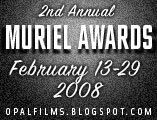* The guy movie to end all guy movies: A bunch of misfit, mean-eyed macho motherfuckers band together to blow the fuck out of the Nazis... THEIR way. As the soldiers grunt and sweat and bond under the sternly watchful eye of their maverick leader (a template that would fuel many films in the wake of this box-office smash), the testosterone practically oozes through the screen. I think my otherwise smooth-n-clammy self sprouted some chest hair while watching this.
* Manliness extends to the accidentally-iconic casting. A cast that includes Telly Savalas, Charles Bronson, John Casavettes, Jim Brown and Lee fucking Marvin is bound to have a certain red-meat contingent to it, but it's kind of stunning to realize that this wasn't on purpose -- aside from Marvin, none of these guys had hit stardom. Live-wire Casavettes the clear frosh standout here (no wonder he was the only cast member nominated for an Oscar), though Donald Sutherland also gets a great starmaker of a scene ("Neeeever heard of it.") and Bronson shows off to great effect the steel-eyed minimalism that would define his career.
* Robert Aldrich was the right guy for the job here. His tough, gritty sensibilities serve well in both the training scenes and the action scenes, and he knows the specifics of male camaraderie in and out (as evidenced not only here but in some of his other works, e.g. Big Leaguer). He's jaundiced enough, though, to keep this from becoming a hawkfest. Pro-war feel is inevitable, but Aldrich doesn't lose sight of the irony in that these army rejects, these rapists and murderers, are the most competent soldiers in the film.
* There's a certain amount of narrative choppiness, especially during the war-game sequence, that could either be an unusual amount of trust in the audience's ability to fill in blanks or just lax storytelling. I'd like to think it's the former while suspecting it's the latter.
* Submission of the individual to the collective gets an elegant literal representation in the assignation of numbers to the Dozen and their subsequent identification by those numbers alone, only getting their true names back after the mission is completed. Because of the nature of the mission, this results in a few people being re-named posthumously. Such is war.
Grade: B

